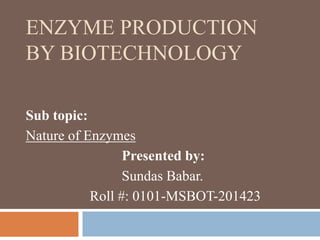
Enzyme production by biotechnology
- 1. ENZYME PRODUCTION BY BIOTECHNOLOGY Sub topic: Nature of Enzymes Presented by: Sundas Babar. Roll #: 0101-MSBOT-201423
- 2. ENZYMES Proteins that function as biological catalysts are called enzymes. Enzymes speed up specific metabolic reactions. Low contamination, low temperature and fast metabolism are only possible with enzymes. Metabolism is fast, with the product made to a high degree of purity. They have molecular weights ranging from 10,000 to 2,000,000.
- 3. General Properties Catalysts Protein Specific Reversible - can catalyse the reaction in both directions Denatured by high temperature and change in pH Rate of action affected by temperature and pH
- 4. Protein Nature of Enzymes Composed of C, H, O and N. Sulphur (S) may also be present. One or more polypeptide chains - large number of linked amino acids. Formed on the ribosome (70s, 80s) – translation of mRNA during protein synthesis. Denatured by high temperature and unfavourable pH.
- 6. CHEMICAL NATURE Many enzymes require the presence of other compounds - cofactors - before their catalytic activity can be exerted. This entire active complex is referred to as the holoenzyme; i.e., apoenzyme (protein portion) plus the cofactor (coenzyme, prosthetic group or metal- ionactivator) is called the holoenzyme.
- 7. Apoenzyme + Cofactor = Holoenzyme According to Holum, the cofactor may be: 1. A coenzyme - a non-protein organic substance which is dialyzable, thermostable and loosely attached to the protein part. 2. A prosthetic group - an organic substance which is dialyzable and thermostable which is firmly attached to the protein or apoenzyme portion. 3. A metal-ion-activator - these include K+, Fe++, Fe+++, Cu++, Co++, Zn++, Mn++, Mg++, Ca++, and Mo+++.
- 9. Folded Shape of Enzymes The polypeptide chains are folded into a particular three-dimensional shape (H-bonds). The correct folded shape is essential for enzyme action ‘tertiary structure’. The shape gives the enzyme special areas known as active sites. The compatible substrate molecules bind to the complementary active site. Different enzymes have a differently shaped active site.
- 10. Role of Enzymes in Living Things: Enzymes catalyse all metabolic reactions. They lower the activation energy – the energy input needed to bring about the reaction. Regulate the thousands of different metabolic reactions in a cell and in the organism. The activity of a cell is determined by which enzymes are active in the cell at that time. Cell activity is altered by removing specific enzymes and/or synthesising new enzymes.
- 11. Specificity of Enzymes One of the properties of enzymes that makes them so important as diagnostic and research tools is the specificity they exhibit relative to the reactions they catalyze. A few enzymes exhibit absolute specificity; that is, they will catalyze only one particular reaction. Other enzymes will be specific for a particular type of chemical bond or functional group. In general, there are four distinct types of specificity: 1. Absolute specificity - the enzyme will catalyze only one reaction. 2. Group specificity - the enzyme will act only on molecules that have specific functional groups, such as amino, phosphate and methyl groups.
- 12. Cont.. 3. Linkage specificity - the enzyme will act on a particular type of chemical bond regardless of the rest of the molecular structure. 4. Stereochemical specificity - the enzyme will act on a particular steric or optical isomer. Though enzymes exhibit great degrees of specificity, cofactors may serve many apoenzymes.
- 13. Active Site Theory “Lock and Key Hypothesis and Induced Fit” The enzyme’s active site has a shape complementary to the substrate. The substrate locks into the active site of the enzyme. The active site alters its shape holding the substrate more tightly and straining it. An enzyme-substrate complex is formed. The substrate undergoes a chemical change – a new substance (product) is formed. The product is released from the active site. The free unaltered active site is ready to receive fresh substrate.
- 15. Industrial Uses of Enzymes Bio processing is the use of biological materials (organisms, cells, organelles, enzymes) to carry out manufacturing or treatment procedures of commercial or scientific interest. Examples include: Glucose isomerase: production of fructose from glucose (sweeter). Sucrase: production of glucose and fructose from sucrose (much sweeter). Glucose oxidase: testing of blood/urine for glucose (diabetics) Pectinase: production of clear juice from apples/grapes etc for cider/wine-making .
